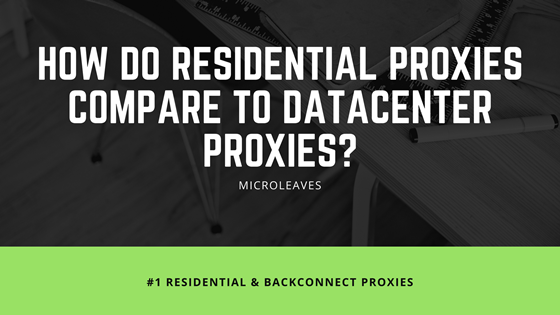The internet is fraught with much potential privacy and cyber loopholes.
This in itself has created a security-conscious cyber community. At such, rules and restrictions is the order of the day.
From internet service providers (ISP) to internet websites restrictions abound and internet users are increasingly burdened and scrutinized by the day especially since every internet user has an IP assigned to them.
But, where’s the fun in that? The internet isn’t fun with restrictions.
For this reason, internet users are always looking for ways to get around these rules by being anonymous before coming online. There are many routes to do this but for this article; we will look at residential proxies and data center proxies.
This article looks at how the two compare.
For this comparison to meet the purpose, it is important to lay a bit of background on what residential proxy and data center proxy are.
Every time you come on the internet, there’s a unique ID called internet protocol (IP) address created for you by your internet provider.
Through this IP address, your location can be pinpointed as well as other information. As long as there’s a straight line of communication, your location will always be identifiable.
To mitigate against this, proxies are the best bet. Proxies basically serve as middlemen between you and the website you’re trying to connect with.
In essence, instead of communicating directly with the website, you communicate with the proxy and the proxy, in turn, communicates with the website with a different IP other than yours. With this, your location and identity remain safe.
That said, there’s still one bit of challenge still, using one singular IP address will never suffice especially depending on what you’re doing online as some websites prevent duplicate actions from the same IP address.
For this reason, if anonymity and access to different sites are your desire, then you need a proxy server that can supply different IP addresses per time. This brings me to the first point of comparison: safety.
Safety
For the most part, residential proxies and data center proxies perform the same function: masking IP addresses, with the difference between in the execution.
Residential proxies supply residential IPs, that is, they are supplied by internet service providers themselves.
What this means is that whatever IP address is seen at the other end is as if a regular human is connecting via the internet.
Now, this swarm of residential IPs is regarded as backconnect proxies. In a backconnect proxy, such as provided by Microleaves, there can be as many as 10, 100, 20,000, or 50,000. The scale and enormity of the setup is dependent on the system owner.
In essence, you can do a Google search with a different proxy connection, click on an interesting link, and another residential proxy sends it, while another connection opens the web page.
And this goes on and on, providing you with different residential proxies as you take different actions on the web. Microleaves for example, has a pool of 26 million residential IPs, giving users massive backconnect opportunities.
This plethora of IPs is one of the differences between data center proxies and backconnect proxies and offers many advantages for internet users.
The major advantage being the amount of request you can make per minute than when you’re stuck with one particular server.
This is particularly important when you’re scrapping data off sites like Google or Amazon due to the limits these sites place on specific IPs.
For example, if Amazon observes many requests from a particular server and location, there’s a validation required with a captcha.
And even after that, many connections will get you blacklisted for exceeding the connection limit per minute.
However, by connecting with different residential IPs using a backconnect proxy, you can use software like Scrapebox and Xrumer without being blacklisted by these sites.
The sites won’t be able to identify and group your connections together to even limit your IP. Even if an IP gets blacklisted – which is rare – the next connection won’t be coming from the same IP anyways.
Data centers cannot make this kind of advantage available because it works with limited amounts of ports and IP addresses.
More so, the IP generated by data centers are different from the IPs generated by residential proxies, which makes them more susceptible to being blacklisted by sites for multiple connections.
Speed
In comparison, data centers are relatively faster, but not all the time. This is because most times, data centers are hosted on dedicated servers created for specific purposes.
On the other hand, the speed of a residential proxy varies depending on the internet service provider supplying the connection.
An ISP in Africa is different from an ISP in Europe, which can also affect reliability because the owners of the residential IPs might be doing data-heavy connection such as downloads and video streaming.
Conclusion
Cloaking IPs has become the norm because of privacy risks and to get around the many restrictions online. To this end, it is imperative to know your requirements are before making your choice.On the basis of the preceding arguments, though, residential proxies and by extension backconnect proxies are far more valuable than data center proxies because they offer conventional residential IPs; thus, creating a safer path to the internet for all concerned.

